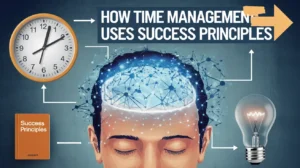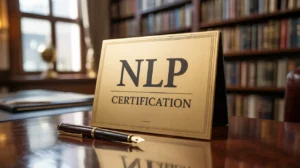Imagine this: your startup is growing fast, and suddenly a competitor launches a product that could change the game. As the CEO, do you pivot, specialize, or double down on your strategy? These are the kinds of moments that define leadership. Every choice affects your company’s future, your team’s morale, and your reputation as a leader.
Good decision-making isn’t just about picking the “right” option. It’s about balancing vision with practicality, acting with confidence, and bringing your team along for the ride. Research shows that leaders who consistently make strong decisions are far more likely to drive positive performance outcomes.
In this guide, let’s explore why decision-making matters, key principles to follow, and practical frameworks you can use to strengthen your leadership.
Why Decision-Making Matters in Leadership
Decisions are the steering wheel of leadership. They determine direction, build culture, and set the pace for growth. A clear and confident decision can unify a team and push projects forward. A poor or delayed one can create confusion, waste time, and erode trust.
Strong decision-making means:
- Aligning choices with organizational goals.
- Creating clarity for the team.
- Minimizing risk while maximizing opportunity.
- Building credibility and trust through transparency.
When leaders treat decision-making as a skill, not just a reaction, they set a strong foundation for long-term success.
Core Principles of Effective Decision-Making
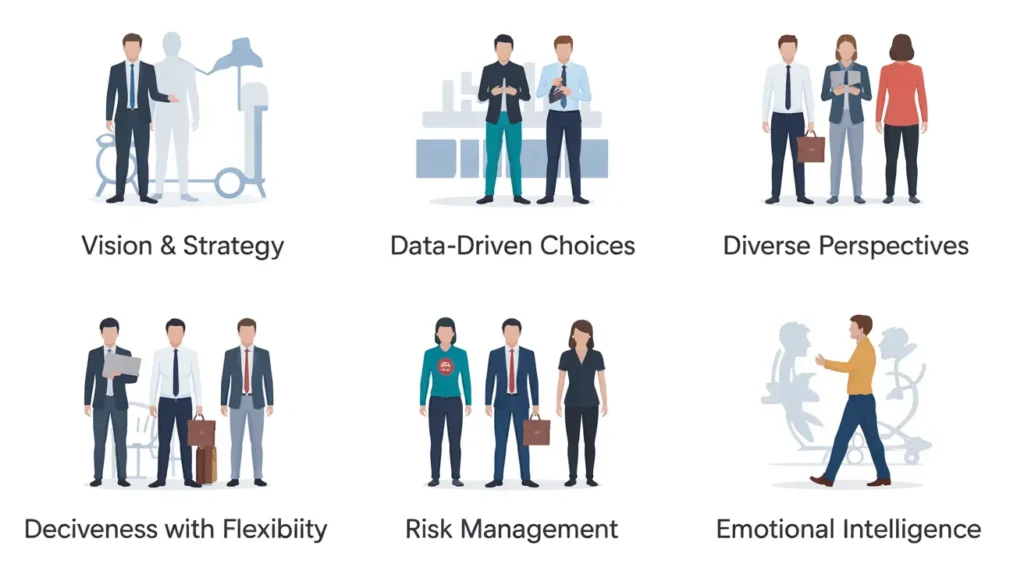
Good leaders don’t just make choices; they make them with clarity and purpose. The core principles of decision-making act like a compass, guiding actions that align with vision and values. These principles help leaders build trust, reduce risk, and move their teams forward with confidence.
Vision & Strategic Thinking
Every decision should point back to the company’s mission and long-term goals. Leaders who focus only on short-term wins often sacrifice future growth. For example, a tech company may delay launching a product to ensure quality and win long-term loyalty instead of rushing for quick profits.
Data-Driven Choices
Intuition has its place, but data brings clarity. Leaders who use analytics, customer insights, and performance metrics reduce guesswork. Imagine a restaurant chain deciding on a new location, demographics, foot traffic, and competitor analysis should guide the choice, not just “gut feeling.”
Diverse Perspectives
No leader sees everything. Involving different voices, finance, marketing, operations, and frontline staff uncovers blind spots and sparks better ideas. This inclusivity not only improves decisions but also boosts team morale, since people feel heard.
Decisiveness with Flexibility
Great leaders don’t stall. They gather enough data (about 70%), then act. But decisiveness doesn’t mean rigidity; it means being ready to pivot when circumstances change.
Risk Management
Every decision carries risk. The best leaders identify those risks, weigh trade-offs, and prepare backup plans. For example, expanding into a new market might bring revenue but also currency and legal risks. Smart leaders plan for both.
Emotional Intelligence
Decision-making isn’t just logical, it’s emotional. Leaders with strong EQ manage stress, understand their team’s feelings, and avoid letting fear or ego cloud their judgment. This makes their choices balanced and fair.
Practical Decision-Making Frameworks
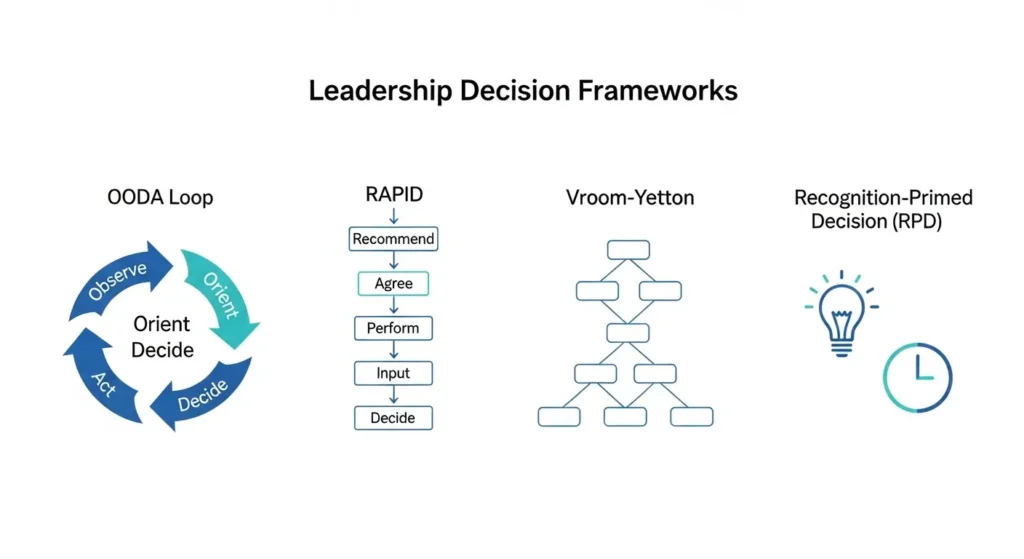
Different situations call for different approaches. Here are some proven frameworks:
- OODA Loop (Observe → Orient → Decide → Act) – Best for fast-changing environments, like crises or competitive markets.
- RAPID Model – Clarifies who recommends, who decides, and who implements, reducing confusion in large teams
- Vroom–Yetton Model – Helps leaders decide whether to act solo, consult the team, or make decisions collaboratively.
- Recognition-Primed Decision (RPD) – Relies on experience to act quickly when there’s no time for analysis.
Using the right model at the right time makes decisions smoother, faster, and more effective.
Creating a Decision-Smart Culture
Leadership isn’t just about making decisions alone; it’s about empowering others to make good ones too. Here’s how to build a decision-smart culture:
- Empower Teams: Delegate when appropriate, don’t bottleneck growth.
- Encourage Feedback Loops: Review outcomes openly to learn and improve.
- Be Transparent: Share reasoning so people trust the process, even if they disagree.
Benefits of Effective Decision-Making
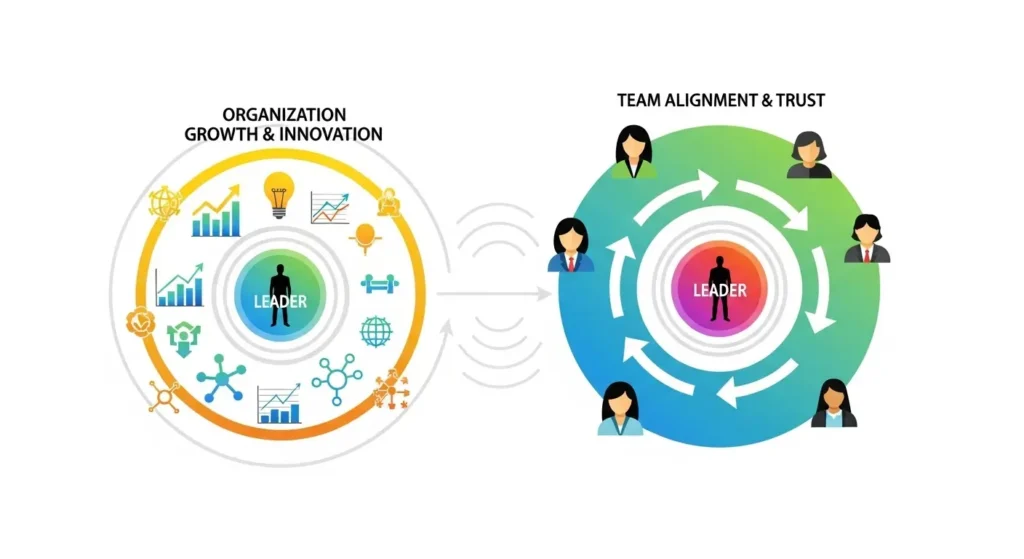
Strong leadership is built on smart decisions. Every choice shapes the direction of a team, the trust within it, and the growth of the organization. Let’s look at the key benefits leaders unlock when they make decisions with clarity and confidence.
Aligns Team Goals
When leaders make decisions with clarity, the entire team understands the “why” behind each choice. This creates a sense of direction where everyone knows how their role contributes to the bigger picture. Alignment not only prevents confusion but also increases motivation, because people feel they’re working toward shared goals rather than isolated tasks.
Builds Trust and Accountability
Trust is at the core of strong leadership, and effective decision-making reinforces it. When leaders communicate openly about their reasoning and take responsibility for outcomes, employees feel respected and valued. This transparency inspires loyalty, strengthens team morale, and fosters a culture where accountability is seen as a shared responsibility.
Drives Sustainable Growth
Good decisions balance short-term wins with long-term vision. Leaders who weigh immediate needs like meeting quarterly targets against future goals create a growth path that can withstand challenges. By making choices that prioritize sustainability, organizations build resilience and avoid the pitfalls of chasing quick but risky gains.
Encourages Innovation and Creativity
Leaders who welcome diverse input in the decision-making process naturally unlock more innovative ideas. Different perspectives reveal fresh solutions, reduce blind spots, and empower team members to think outside the box. This collaborative environment encourages creativity and adaptability, helping organizations thrive in a competitive landscape.
Boosts Efficiency and Reduces Risk
Structured, thoughtful decision-making helps leaders anticipate challenges and address them early. By assessing risks before taking action, organizations can prevent costly mistakes and wasted resources. This proactive approach improves efficiency, allowing teams to focus their energy on high-impact activities that drive performance and results.
Key Takeaways
- Effective decisions combine vision, data, empathy, and adaptability.
- Using decision frameworks keeps choices structured and reduces bias.
- A decision-smart culture strengthens trust, innovation, and resilience.
Conclusion
Decision-making is the backbone of effective leadership. The best leaders combine strategy, data, emotional intelligence, and adaptability to make choices that drive growth and build trust. By using proven frameworks and fostering a decision-smart culture, leaders can guide their teams through uncertainty with confidence.
At the end of the day, strong decision-making isn’t about always being “right.” It’s about being clear, transparent, and ready to learn because every decision, big or small, shapes the future of your organization.
FAQs
How can leaders avoid “analysis paralysis”?
Leaders should avoid overthinking by gathering about 70% of the information needed, then committing to a decision. Setting clear deadlines prevents endless delays. Taking action creates momentum, and adjustments can be made as new insights emerge.
Should leaders trust gut instinct or data more?
Both intuition and data play important roles. Gut instinct helps leaders spot patterns and opportunities quickly, while data provides evidence and reduces bias. The most effective leaders combine both using intuition to guide, then validating with data before deciding.
Which framework is best for quick decisions?
The OODA Loop (Observe, Orient, Decide, Act) is especially effective in fast-changing situations. It encourages leaders to act quickly while staying flexible. By continuously cycling through the steps, decisions remain adaptive to real-time conditions.
How do you make better team decisions?
Strong team decisions come from encouraging diverse input and perspectives. Frameworks like RAPID clarify roles and accountability, making the process structured. Leaders should also communicate the “why” behind final choices to ensure trust and alignment.
What if a decision turns out wrong?
Every leader makes mistakes, but credibility comes from owning them instead of hiding them. Reviewing what went wrong and sharing lessons builds team learning. The key is to pivot quickly, turning setbacks into growth opportunities.



